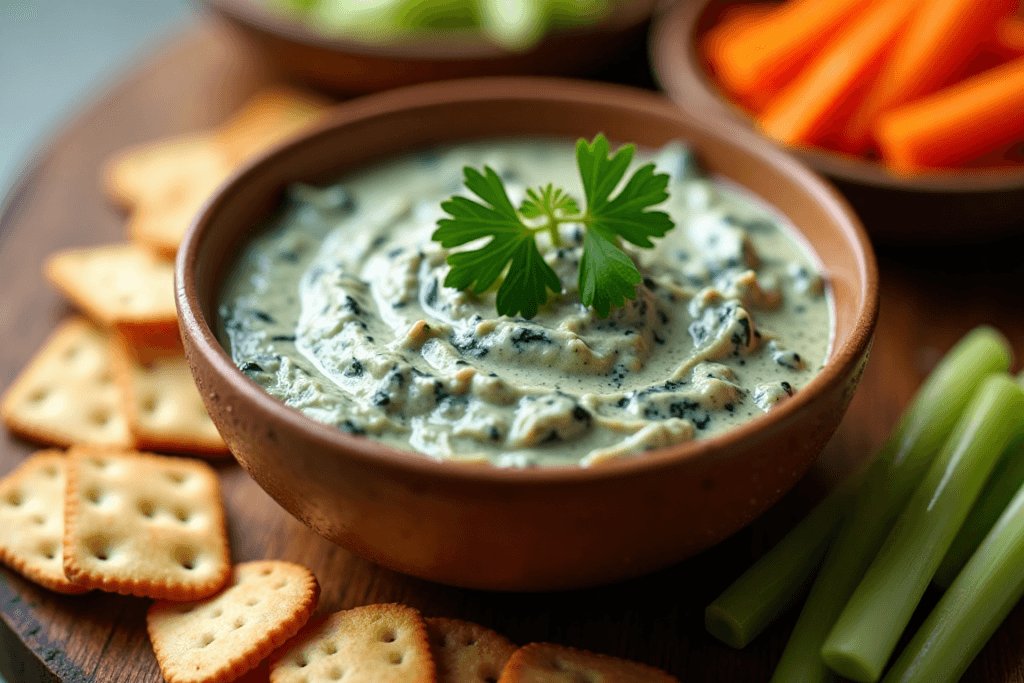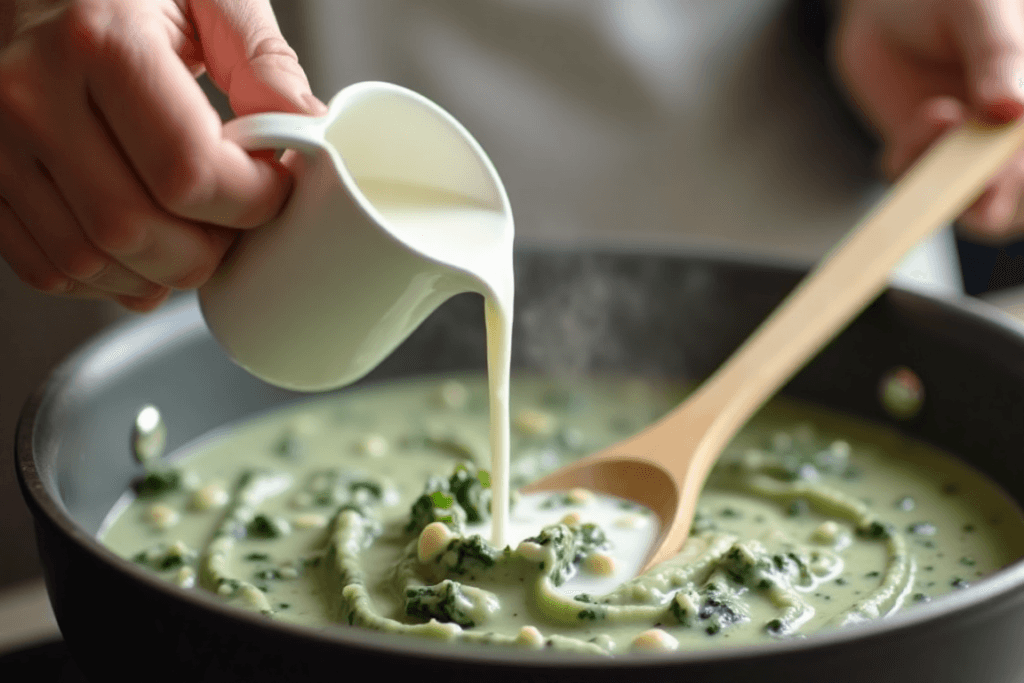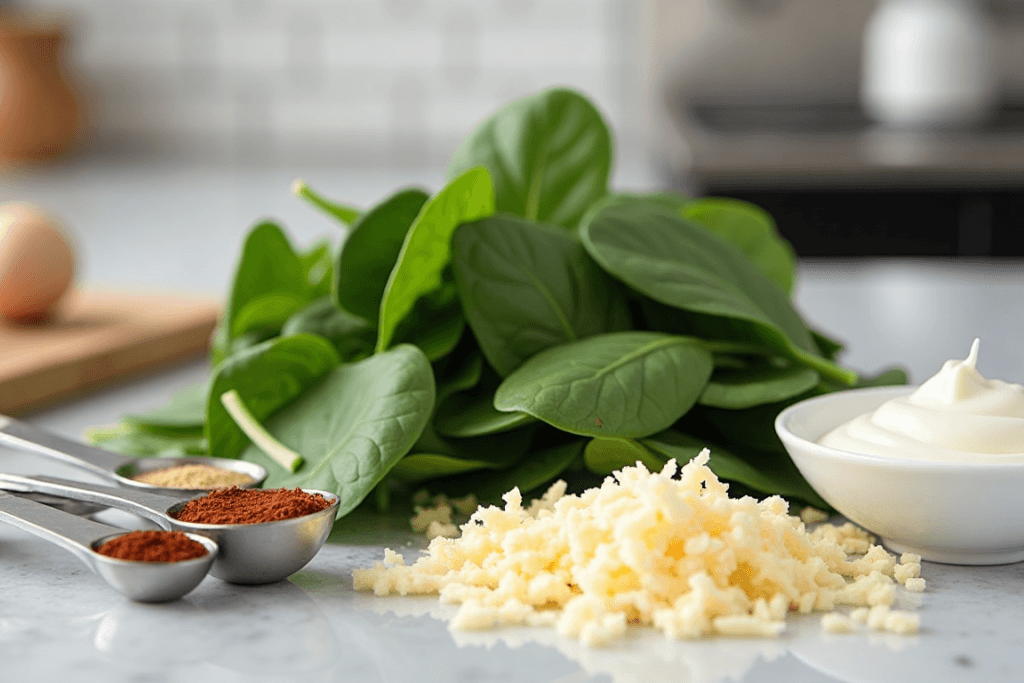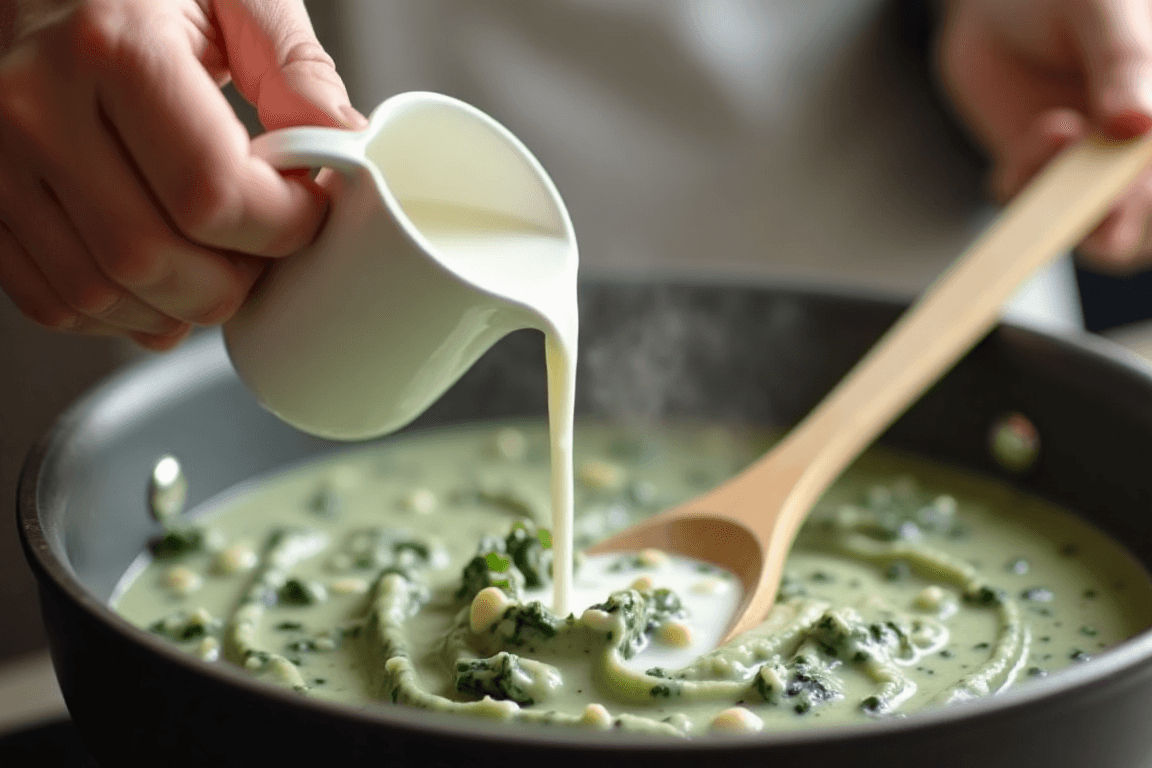Introduction
Spinach dip is a beloved party appetizer, combining the creaminess of dairy with the earthy flavor of spinach. It’s perfect for pairing with crackers, chips, or fresh veggies. However, achieving the ideal consistency can sometimes be tricky. One common problem cooks encounter is an overly thick spinach dip, especially when preparing it on the stove.
A thick dip may feel heavy, lose its spreadability, and detract from the overall experience. Understanding the reasons behind this issue and how to address it ensures you can always serve a crowd-pleasing dish. In this article, we’ll explore the causes of thick spinach dip, how to fix it, and tips to prevent it in the future.

Common Causes of Thick Spinach Dip
Crafting the perfect spinach dip requires balancing the ingredients and cooking method. When it turns out too thick, pinpointing the cause is essential to fixing it. Below are the most common reasons your spinach dip may be thicker than desired when prepared on the stove.
Using Too Much Spinach
Spinach is the star of the dish, but overloading it can backfire. Fresh spinach has a high water content, but during cooking, much of this moisture evaporates. When you add more spinach than the recipe calls for, the liquid ingredients might not be enough to maintain a creamy consistency. Frozen spinach can pose a similar challenge if it’s not properly thawed and drained. Excess liquid from frozen spinach may alter the dip initially, but as the moisture cooks off, the dip thickens excessively.
Solution: Measure your spinach carefully and ensure frozen spinach is thoroughly thawed and squeezed to remove excess water before adding it to the mix.
Insufficient Liquid Ingredients
The liquid components of your recipe—such as milk, cream, sour cream, or broth—play a crucial role in keeping the dip smooth and creamy. If you reduce the liquid ingredients or forget to add them, the dip can quickly become too dense. This issue is often amplified if you adjust the recipe for a smaller portion but fail to adjust the other ingredients proportionally.
Solution: Stick to the recommended measurements for liquids and don’t hesitate to add a splash more milk, cream, or broth if the mixture seems too dry during cooking.
Overcooking the Dip
Cooking spinach dip on the stove requires careful monitoring of heat and time. Overcooking, especially at high temperatures, can lead to excessive evaporation of the liquid components. As the liquid reduces, the dip thickens, sometimes turning gummy or even lumpy.
Solution: Use medium to low heat and stir frequently to prevent the liquid from reducing too much. Avoid leaving the dip unattended, as even a few extra minutes on the stove can significantly alter the texture.
Incorrect Proportion of Cheese or Other Thickeners
Cheese, cream cheese, or heavy cream are often included in spinach dip recipes for richness and flavor. However, adding too much of these thickeners can overwhelm the dish. Their natural density can turn the dip into a paste-like consistency if not balanced with sufficient liquid. Similarly, thickeners like flour or cornstarch can contribute to excessive thickness when not used sparingly.
Solution: Measure cheese and thickeners precisely. If the dip begins to feel overly thick, adding a bit of milk or broth can help loosen it up without sacrificing flavor.
Adding Flour or Cornstarch Incorrectly
Some recipes call for a roux (flour and butter mixture) or cornstarch slurry to thicken the dip. While these are effective tools for creating a creamy texture, using too much or not dispersing them evenly can result in a clumpy, overly dense mixture.
Solution: If using flour or cornstarch, ensure it’s evenly whisked into a liquid base before adding it to the spinach dip. Avoid adding it directly to the hot dip, as it may not distribute evenly.
Solutions for Fixing a Thick Spinach Dip
If your spinach dip has turned out too thick, there’s no need to panic. Several simple techniques can restore the creamy, velvety texture you’re aiming for. Let’s explore effective ways to fix a thick spinach dip and bring it back to its perfect consistency.

Adjusting Liquids
Adding more liquid is the most straightforward way to thin out a thick spinach dip. Depending on the ingredients in your recipe, you can use milk, cream, or even a splash of vegetable or chicken broth.
- Gradual Addition: Pour the liquid into the dip slowly, about a tablespoon at a time, while stirring continuously to ensure it incorporates smoothly.
- Match the Flavors: If your dip has a dairy base, stick to milk, cream, or half-and-half. For a lighter option, water or broth can also work, though they may slightly dilute the flavor.
Pro Tip: Warm the liquid before adding it to the dip to prevent temperature shock, which can cause separation or clumping.
Temperature Control
Excessive heat can evaporate liquids and make your dip even thicker, especially when trying to fix it on the stove. To correct the consistency without further thickening:
- Lower the heat to the minimum setting or remove the dip from the heat altogether.
- Allow the mixture to cool slightly before adjusting its consistency with liquids.
- Stir gently and frequently to ensure even distribution of heat and ingredients.
Pro Tip: A double boiler can help you warm the dip gently, preventing the ingredients from separating or burning.
Adjusting Ingredient Ratios
Sometimes, the issue lies in the balance of ingredients. If you suspect that you’ve added too much cheese, spinach, or thickener, adjust the ratios by introducing complementary ingredients.
- Add a Dairy Component: Incorporate a dollop of sour cream, cream cheese, or Greek yogurt to reintroduce creaminess while slightly loosening the texture.
- Balance with Spinach or Liquids: If the cheese content feels overpowering, fold in more spinach or liquid to restore balance.
Pro Tip: Taste the dip as you adjust to ensure that the flavors remain harmonious.
Techniques for Reheating
When reheating spinach dip leftovers, it’s common for the texture to thicken further. To avoid this, follow these steps:
- Reheat Slowly: Use low heat and stir frequently to prevent scorching and uneven thickening.
- Add Liquid During Reheating: Incorporate a splash of milk or cream as you reheat to maintain a smooth texture.
- Use the Microwave Carefully: Heat in short intervals (20–30 seconds), stirring in between to ensure even heating.
Pro Tip: Avoid reheating spinach dip multiple times, as this can degrade its texture and flavor.
Preventing a Thick Spinach Dip in the Future
The best way to address the problem of a thick spinach dip is to prevent it from happening in the first place. By following these tips and techniques, you can ensure your dip consistently turns out creamy, smooth, and perfectly textured.

Measuring Ingredients Accurately
Precision in ingredient measurement is crucial for achieving the right consistency in spinach dip. Overloading or under-measuring certain components can easily disrupt the balance.
- Use Measuring Tools: Invest in accurate measuring cups and spoons to ensure you follow the recipe precisely.
- Weigh Ingredients When Possible: For components like cheese or spinach, weighing on a kitchen scale can provide a more exact amount than eyeballing.
- Follow the Recipe: Avoid the temptation to experiment with proportions, especially when making the dip for the first time.
Pro Tip: Write down any modifications you make to a recipe that turn out well, so you can replicate them in the future.
Cooking Tips for Spinach
The type of spinach you use and how you prepare it can greatly influence the dip’s texture. Here are key considerations for managing fresh or frozen spinach effectively:
- Fresh Spinach: Wash thoroughly and pat dry before cooking to minimize excess moisture. Chop finely to ensure even distribution in the dip.
- Frozen Spinach: Thaw completely and press it in a colander or clean towel to remove as much water as possible.
- Avoid Overcooking: Whether using fresh or frozen spinach, cook it lightly before adding it to the dip. Overcooked spinach loses too much water and can make the final texture unpredictable.
Pro Tip: For a smoother dip, puree the spinach slightly before mixing it into the dip.
Tips for Managing Thickeners
Cheese, flour, cornstarch, and other thickeners can make or break the consistency of your dip. Use these tips to manage them effectively:
- Cheese: Choose melt-friendly varieties like mozzarella, Monterey Jack, or Gruyère. Use them sparingly and evenly distribute them during cooking.
- Flour or Cornstarch: If you’re using these as thickeners, dilute them in a liquid (like milk or broth) before adding them to the dip. This prevents clumps and ensures even thickening.
- Cream Cheese or Sour Cream: Blend these components into the dip while it’s warm to achieve a smooth consistency.
🔗 Related Read: Learn how to balance ingredients and achieve the perfect dip texture in Knorr Spinach Dip: The Ultimate Guide.
Managing Cooking Time and Heat
Spinach dip often thickens excessively due to overcooking or high heat. To maintain the ideal consistency:
- Cook on Low to Medium Heat: High heat may cause the dip to thicken unevenly or burn at the bottom of the pan.
- Stir Frequently: Regular stirring ensures even cooking and prevents the dip from sticking to the pan or forming lumps.
- Monitor Cooking Time: Keep an eye on the dip and remove it from heat as soon as the ingredients are combined and warmed through.
Pro Tip: If preparing the dip in advance, slightly undercook it and finish reheating just before serving.
By adopting these preventative measures, you’ll not only avoid overly thick spinach dip but also gain confidence in preparing this classic appetizer to perfection every time.
FAQs
To further ensure success with your spinach dip, here are answers to some of the most common questions related to achieving the perfect texture and consistency.
Can I fix my dip if it’s already served?
Yes, you can still adjust the consistency of spinach dip even if it has already been served. If it’s too thick, offer a small pitcher of warm milk, cream, or broth on the side for guests to stir into their portions. Alternatively, you can return the dip to the stove briefly, add liquid, and stir until it reaches the desired texture.
Pro Tip: If adjusting during serving, warm the liquid slightly before adding it to avoid cooling the dip.
Is fresh spinach better than frozen for dip?
Both fresh and frozen spinach work well for dips, but they have different characteristics:
- Fresh Spinach: Adds a vibrant color and fresh taste. It requires proper washing, drying, and chopping to prevent excess water.
- Frozen Spinach: Convenient and pre-chopped, but must be thoroughly thawed and drained to avoid waterlogging the dip.
Pro Tip: Choose fresh spinach for a lighter dip and frozen spinach for convenience and consistency in texture.
What if my dip is too runny instead?
If your spinach dip is too runny, there are a few ways to thicken it:
- Simmer Longer: Gently simmer on low heat to reduce excess liquid.
- Add Thickeners: Stir in a small amount of cornstarch slurry or a handful of shredded cheese to bind the mixture.
- Incorporate Creamy Ingredients: Blend in more cream cheese or sour cream to thicken while maintaining creaminess.
Pro Tip: Use these methods sparingly to avoid over-thickening the dip again.
Can I substitute milk or cream with non-dairy options?
Yes, non-dairy options like almond milk, coconut milk, or cashew cream can be used in spinach dip. However, these alternatives may slightly alter the flavor and consistency:
- Cashew Cream: Best for achieving a rich and creamy texture.
- Coconut Milk: Adds a subtle sweetness that pairs well with certain spices.
- Almond Milk: Light and neutral but may need thickening agents like cornstarch for desired consistency.
Pro Tip: Unsweetened and unflavored non-dairy milks work best for savory dishes like spinach dip.
What cheese works best for spinach dip?
Cheese is a critical ingredient in spinach dip, contributing to its flavor and texture. Ideal options include:
- Mozzarella: Offers stretchiness and mild flavor.
- Parmesan: Adds a nutty and sharp taste.
- Monterey Jack or Gruyère: Both melt beautifully and enhance the creaminess.
- Cream Cheese: Acts as a base, providing smoothness and body.
Pro Tip: Use a mix of cheeses for depth of flavor and balanced consistency.
Can spinach dip thicken naturally as it cools?
Yes, spinach dip often thickens as it cools because the cheese and other thickeners firm up at lower temperatures. To avoid serving a dip that becomes too thick over time:
- Serve the dip warm or reheat it gently as needed.
- Add a touch of extra liquid during preparation to allow for natural thickening.
Pro Tip: Keep the dip warm using a slow cooker or warming tray to maintain its ideal texture throughout serving.
Conclusion
A perfect spinach dip is a crowd-pleasing dish, loved for its creamy texture and robust flavor. However, an overly thick dip can dampen the experience. By understanding the common causes—such as excessive spinach, insufficient liquid, or overcooking—you can easily identify and address the problem.
Incorporating solutions like gradually adding liquid, balancing ingredient ratios, and controlling cooking temperature ensures a creamy, well-balanced dip every time. Moreover, by following preventative tips such as accurate measurements, proper preparation of spinach, and careful use of thickeners, you can avoid the issue entirely.
Finally, addressing common questions about fixing, substituting, and choosing ingredients for your spinach dip enhances your ability to master this classic appetizer. Whether preparing it fresh or reheating leftovers, these tips and techniques will help you serve a spinach dip that’s always a hit.
With this knowledge, you’re ready to tackle any spinach dip challenge and create a dish that’s perfect for every occasion. Would you like me to provide details for the image section?

